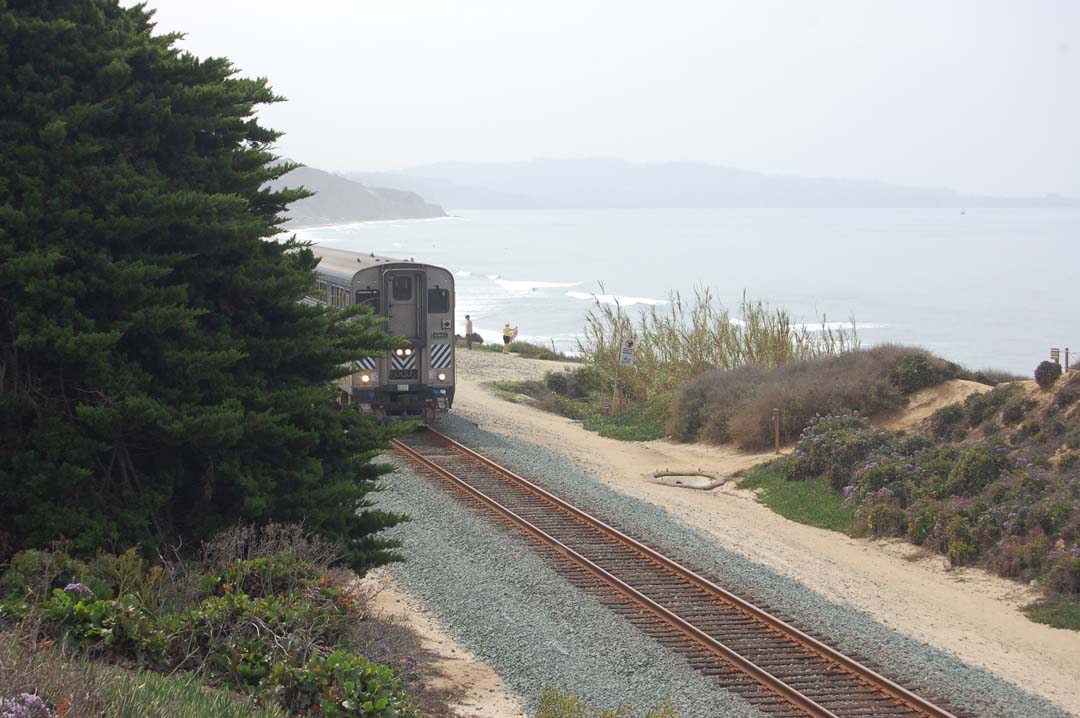DEL MAR — It’s a project more likely to move at a snail’s pace than train speed, but plans to remove the railroad tracks from Del Mar’s fragile bluffs are getting some renewed attention from the San Diego Association of Governments.
The upcoming fiscal year budget for the regional policy-making agency includes a few hundred thousand dollars for a feasibility study to review and update existing options and information, Councilman Dwight Worden reported at the March 20 City Council meeting.
“It really is good news,” Worden said. “Hopefully what will come out of that is up-to-date, better information on how these alignments work or don’t work and what the tunnel options are.”
About 10 years ago, when SANDAG received money from the Federal Railroad Administration for the San Dieguito River Bridge replacement, there was a requirement to study tunnel options.
“We had to look at several different alignments for tunnels because we didn’t want the bridge pointing in the wrong direction,” Gary Gallegos, SANDAG’s executive director, said. “So we’re going to build on what we’ve already done.”
Three alternatives with five tunnel alignment options were proposed, all with varying benefits and disadvantages.
An open trench-and-cover down Camino del Mar, for example, was the only option that didn’t impact residential areas and was the least expensive at $450 million. However, there are significant utility conflicts along the roadway and construction would negatively impact businesses.
“The longer tunnels that don’t go under Camino del Mar are straighter so the trains can go faster and that’s a big advantage to train operations to be able to keep speed up, but they’re deeper and longer,” Worden said.
Tunnels under Crest Canyon and near Interstate 5 were in the billion-dollar range.
An environmental impact report completed in 2009 for the bridge replacement considered the Camino del Mar option and one other alignment.
An environmental constraints analysis, which Worden described as “a quick-and-dirty” assessment, determined all five alignments would work.
Worden said he and Mayor Terry Sinnott agree the best strategy is for Del Mar to work in conjunction with the other North County coastal cities up to Oceanside, “saying we had some kind of a vision of what the whole corridor should be like.”
“Terry and I agreed we would do an outreach to the people interested in rail issues on those councils,” Worden added. “Hopefully then it won’t just be us advocating for what we want. But it’ll be a north coast coalition because otherwise, you know how that goes. Somebody will think you’re trying to steal my … money for your tunnel.”
“I think our hope, primarily, is that we build a better case … for the region to want to complete this effort sooner rather than later,” Sinnott said. “So we may poke into a couple of areas that we haven’t poked into before but it’s nice to get all the information that’s already been developed so we’re not having to start from ground zero.”
SANDAG staff included funding for the feasibility study in the upcoming budget because the agency is working on an update to its regional transportation plan. The long-term goal is to remove the tracks from the bluff by 2050.
In addition to being in danger of collapsing during a major bluff failure, they pose a safety risk for pedestrians. There is approximately one death per month on the tracks along the San Diego coastal corridor, including about three in one recent year in Del Mar.
To increase safety, North County Transit District last year began stepping up enforcement efforts by issuing warnings and citations to people crossing the tracks at undesignated areas.
That has angered many residents and visitors because in Del Mar the only legal crossing along the 1.6-mile coastline is at Coast Boulevard.
As a result, in most of the city, the tracks create a barrier, limiting access to the beach and tempting people to cross illegally and unsafely.
In 2014, SANDAG’s regional transportation plan put the estimated cost of a tunnel and double tracking at $1.3 billion, meaning nothing will happen overnight.
“It’s going to be a long process,” Worden said. “But this is a very key first step.
The 2018 fiscal year budget is scheduled for adoption by the SANDAG board of directors May 26.

